By Val Hewson
The Brandons is, I think, the first Angela Thirkell novel I read, and it remains a favorite.
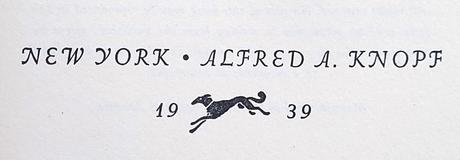
Hilary Temple of the Angela Thirkell Society reviewed The Brandons for Reading 1900-1950 here, illustrating perfectly why it is one of Thirkell’s most popular novels. When I found a second-hand copy recently, it seemed to me that the book itself, the blurb and something tucked inside all added to the story of how the novel became a success.
The Brandons is classic Thirkell. The author is, in her eighth novel, very much at home in her adopted county of Barsetshire. The tone is both sunny – the book was written before World War II and the austerity which followed – and sharp, with Thirkell characteristically taking aim at pretension and bad taste. At the book’s center is a delightful widow, Lavinia Brandon, who has a daughter, a son, an aunt by marriage and a distant cousin. There is a difficult family inheritance to be sorted out, while the Brandons and their neighbours meet at church, at the village fête and at each other’s houses for lunch, tea and dinner. Social hierarchies are always evident but servants and masters, and servants and servants, all compete in the game of one-upmanship. Young love and mature love are displayed in all their sweetness and foolishness. This is Thirkell at her best, and that is very good indeed.
Very good seems to have been the general feeling. In the Tatler, for example, Richard King wrote:
The plot meanders along very pleasantly, and really is very funny indeed. Mrs Thirkell’s slyly quiet humor has rarely been better displayed.
The Tatler, Wednesday 19 April 1939
In her biography of Angela Thirkell, Anne Hall records that:
In July, Jamie Hamilton [Thirkell’s publisher] informed Angela that with The Brandons she had made her bow on the American bestseller list…
Dr Anne Hall, Angela Thirkell, A Writer’s Life (Unicorn, London, 2021), p.98[i]
The book
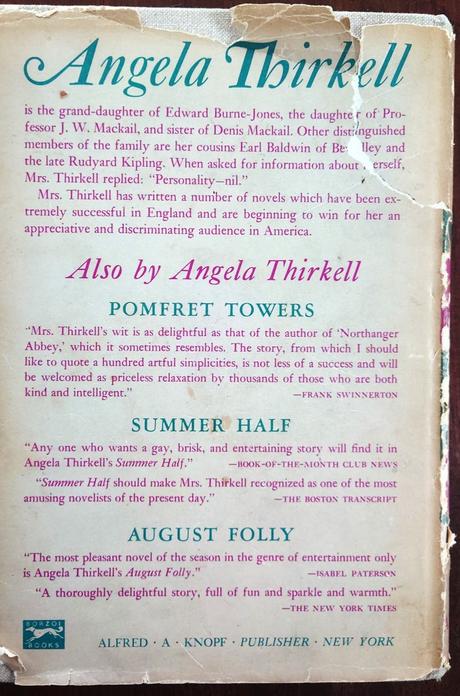
Thirkell’s American publishers were Alfred and Blanche Knopf, and my second-hand copy is one of theirs. It’s an attractive first edition with beige boards and elegant, red lettering and, on the front, also in red, a little sketch. The Knopfs’ famous ‘coursing borzoi’ logo makes several appearances. The dust jacket, now rather worn, has a design of red roses against a blue background and describes Thirkell as ‘Author of Pomfret Towers and other delightful novels’. On the back there are reviews of Pomfret Towers (1938), Summer Half (1937) and August Folly (1936) and a brief biography. Well, it is not so much a biography as a list of the famous men Thirkell happened to be related to:
the grand-daughter of Edward Burne-Jones, the daughter of Professor J W Mackail, and sister of Denis Mackail … her cousins Earl Baldwin of Bewdley and the late Rudyard Kipling.
Thirkell’s cousin, by the way, was no mere earl but, until 1937, the British Prime Minister, Stanley Baldwin. The paragraph finishes by saying that the novels ‘are beginning to win for [Thirkell] an appreciative and discriminating audience in America’.
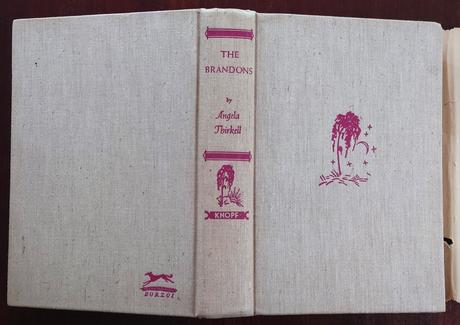
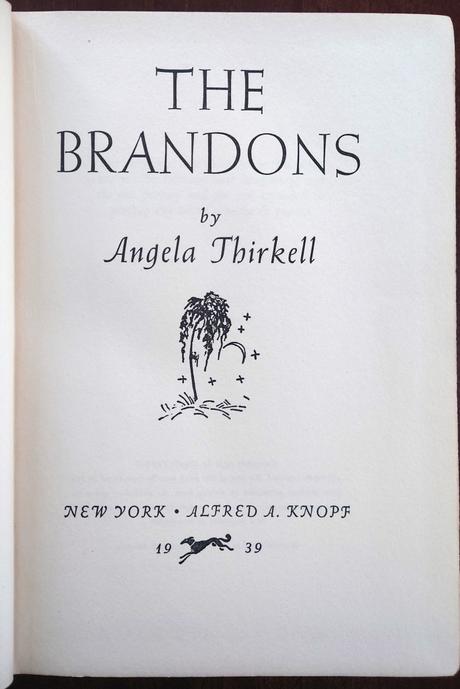
I bought the book in Wimborne, or maybe in Winchester. I can’t remember. How this 1939 US edition got to the south coast of England in 2022 is not clear, except that it came via the second-hand book trade in Canada, for there’s a blurred stamp on the inside of the back cover:
Fraser Book Bin Ltd
Over a Million Books
1247 Granville St
Vancouver 2, BC.[ii]
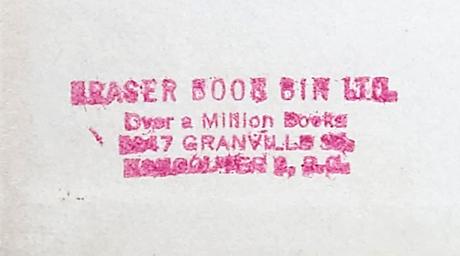
Canada’s Global News (12 November 2012) records that Ted Fraser’s Book Bin was Vancouver’s oldest second-hand bookshop, opening in 1946 and closing, under another name, in 2012.
There’s one last clue to the book’s journey: the name ‘Gordon G McGee’ written inside the front cover. Unfortunately, Gordon didn’t date or locate his signature. According to Canadian voters’ lists (thank you, Ancestry), there were several Gordon McGees living in Vancouver in the 1940s, 1950s, 1960s and 1970s. It might, for example, be Gordon McGee, a salesman, who in 1940 lived at 471 East 11th Avenue in Vancouver, with George, Mrs George, James and Ronald McGee. It would be good to think that Gordon one day went into Ted Fraser’s bookshop and bought a novel called The Brandons. For all I know, however, he became part of the book’s history in some other place and time. (If anyone knows more, please do get in touch.)
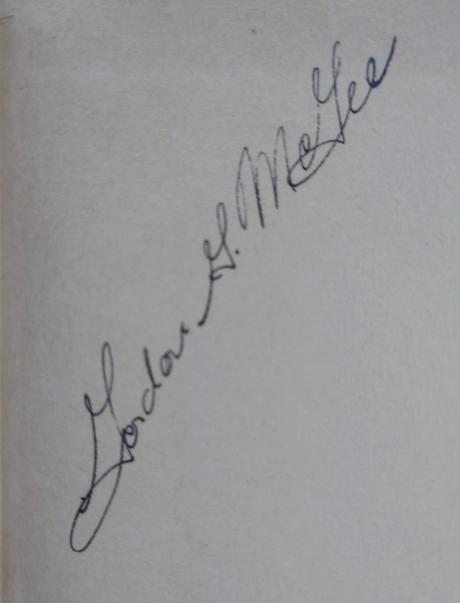
The blurb
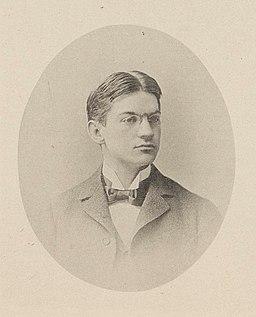 William Lyon Phelps as a young man
William Lyon Phelps as a young man
The blurb on the dust jacket starts with a quotation from William Lyon Phelps (1865-1943). A Harvard professor and popular critic of contemporary literature, Phelps had a syndicated daily newspaper column and often wrote for Scribner’s and other magazines. Quoting him suggests both academic respectability and popular appeal.
I regard Angela Thirkell as one of the cleverest and most entertaining writers of fiction in contemporary literature. Every one of her novels has a good story as its basis; the characterization is both accurate and subtle; and the style both in description and in conversation continually sparkles with humor. I don’t know of any better contemporary novelist to recommend to intelligent persons who are looking for books that combine cerebration with charm. Furthermore, her pictures of British society are as instructive as they are amusing.
The story is then outlined and the blurb finishes: ‘Altogether as diverting a set of characters as Mrs Thirkell has yet invented and an excellent antidote to crises of any kind.’
Tucked inside
That is all the book itself has to tell but tucked inside my copy is a Book of the Month flyer. Did it come with the book as a loose insert? Or did someone seek the book on its recommendation and then tidily keep review and book together?
Founded in 1926, the Book of the Month club proved so popular that its choices were more or less guaranteed success. The club had a policy of noticing new and less well-known authors, as Thirkell would have been in late 1930s USA. The flyer, reprinted from the club newsletter, is by the writer and social and educational reformer, Dorothy Canfield (1879-1958).[iii] Perri Closs in The New Yorker says:
As one of the founding figures of the Book-of-the-Month Club … she was responsible for choosing the books that every educated American was supposed to read, and she used that position to champion writing she believed in …
(Perri Closs, The New Yorker, 27 February 2023)
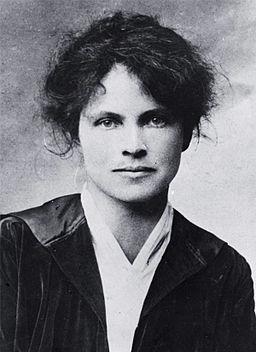 Dorothy Canfield (public domain)
Dorothy Canfield (public domain)
Of The Brandons Dorothy Canfield writes:
As smelling salts for an era of universal jitters, the Brandons are perfect. It is a long time since your selecting committee has been so universally amused by a novel. … To laugh lightheartedly over a novel is the last thing any responsible person in 1939 expects. And who should imagine that – from England of all places right now – a book about English country life would provide a long evening of undiluted entertainment, to the point of rising to hunt up somebody else to read aloud a passage simply too delicious to be savored alone? …
Well, if any austere reader wants to particularize, and asks, in this dark year of moral misery, who would want to fool away his time reading The Brandons, the only accurate rejoinder would be, ‘Anybody! Everybody!’ I myself can’t imagine anyone, not in the throes of a bad toothache, who would not delight in Mrs Brandon, lovely, gracious, lazy, frivolous-minded nit-wit that she is …
But no, there’s no use trying to describe the book by telling what’s in it, for the magic is in the telling. … This novel offers the particular kind of highly sensitive amusement one can get in the (now infrequent) drawing-room comedy, the best of its kind. It is a singularly attractive example of an older form of entertainment, cunningly adapted to a present mood. It makes no meretricious appeal of any sort and relies on the simple resources of clear humor and clear skill. In a generation somewhat dazed by sensationalism it will be interesting to see how many discern this quality of artfulness. Those who have the good luck to discover it may count on a pleasure which is full of reward, and reserved for readers whose tastes have not been entirely bedevilled.
How Angela Thirkell must have welcomed this perceptive review from across the Atlantic. With the Knopfs, Phelps and Canfield – and of course the quality of The Brandons – she was on her way to American acclaim.
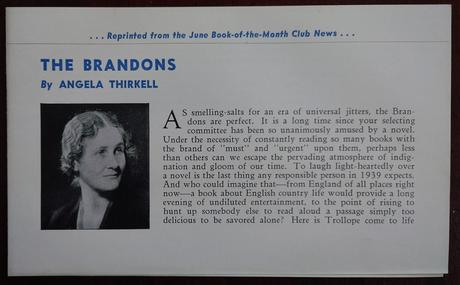
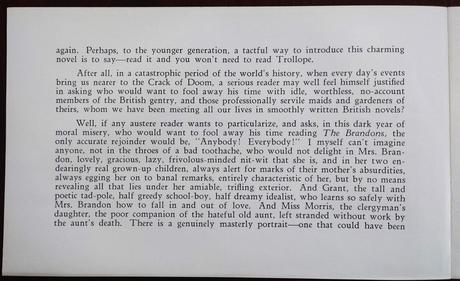
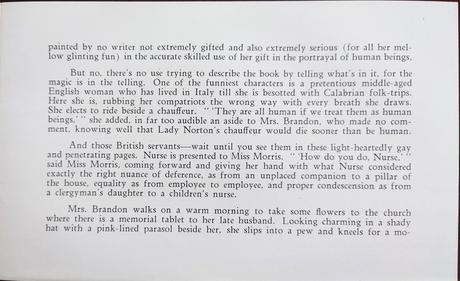
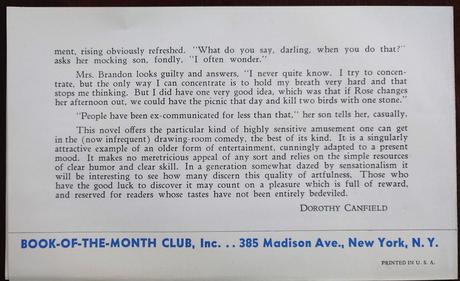
[i] Thanks to Hilary Temple for pointing this out to me.
[ii] And thanks to Anne Hall for helping me decipher the bookseller’s stamp.
[iii] Two of Dorothy Canfield’s novels for adults, The Home-Maker (1924) and The Deepening Stream (1930) are available from Persephone Books, where she is known as Dorothy Canfield Fisher.
